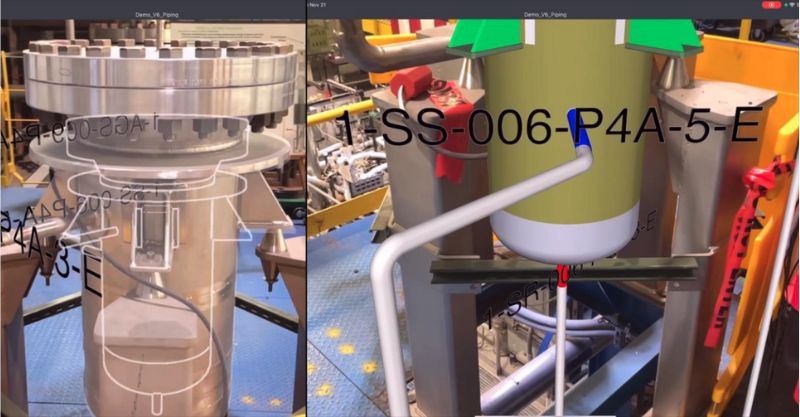Video Gaming Model Trains Next-Gen Nuclear Engineers
A compelling use case for how extended reality and video game-inspired tools can be used to train the next-generation energy workforce.
A team of engineers at the Argonne National Laboratory in Illinois recently produced a compelling use case for training digital-native engineers and technicians at nuclear power facilities. Their pilot program aimed to create training materials that engage the fourth generation of nuclear plant workers—those who came of age after most of the nation’s reactors were built.
A recent pilot program at the Mechanisms Engineering Test Loop facility incorporated computing-enabled hardhats (pictured above) and other extended reality technologies to train the next generation of nuclear workers. Image used courtesy of Argonne National Laboratory
The researchers incorporated extended reality and video game-style content into everyday maintenance, operations, and design tasks at the Mechanisms Engineering Test Loop (METL) liquid metal experiment facility near Chicago.
Specifically, they tested augmented reality (AR) and high-fidelity visualization software to make operations more efficient and accessible off-site from anywhere. The program employed computing-enabled hardhats, virtual joysticks, and other applications under the broader extended reality umbrella. Outside of AR, the work also covered assisted reality (aR), mixed reality (MR), and virtual reality (VR) examples.
Video used courtesy of Argonne National Laboratory
The engineers detailed their findings in a 26-page report, aiming to build a blueprint for digital operations and maintenance tasks at privately run commercial reactors.
Addressing Information Gaps
METL is a liquid metal research site that dispatches purified reactor-grade sodium to various test vessels used to experiment with components for a prototypical advanced nuclear reactor. The facility features tanks with 750 gallons of sodium, more than 1,000 sensors, 300 heater zones, and prototypic reactor temperatures reaching 1,202 degrees Fahrenheit. It’s an incubator for nuclear technologies with commercial potential, including advanced fuel handling system components, self-actuated control and shutdown systems, thermal hydraulic testing, and advanced sensors and instrumentation.
Like any advanced testing facility, METL employs engineers spanning a range of specialties, from operation/maintenance procedures and computer-aided design (CAD) modeling to waste management, architecture, welding, and fabrication. Case in point: Argonne’s job-search portal has nearly 100 postdoctoral jobs in fields such as heavy element chemistry, urban earth science, quantum optics, atomic layer deposition, nuclear chemical separations modeling, and autonomous material discovery.
Seen through a mixed reality headset, this image shows the before (left) and after (right) view of an economizer with and without a container. Image used courtesy of Argonne National Laboratory
To help bridge some of these gaps in specialties, the Argonne team devised training and operational programs utilizing off-the-shelf headsets, high-fidelity visualization tools, tablets with light detection and ranging (LiDAR) compatibility, and hardhats paired with advanced optics, voice-activated functions, and short-range wireless systems.
The researchers worked with digital twin consulting firm Implexus Lab to develop a VR environment for METL, collaborating with the Unreal Engine 5 game engine from Fortnite maker Epic Games. They generated a digital twin of METL’s heating system, with a live data feed covering more than 200 heater zones. The team also made a virtual control room, viewable with VR headsets.
TrueScan3D, a 3D scanning service provider, conducted on-site work for AR capturing/imaging and formed an architectural model.
Through a VR application, engineers can visualize the status of METL’s heating system with a color gradient linking to each temperature sensor. Image used courtesy of Argonne National Laboratory
Argonne’s press release cites an example where the engineers stacked images of an 800-gallon sodium tank with various valves and pipes labeled with serial numbers. Though the tank appeared properly fitted in real life, the virtual version enabled a more in-depth visualization showing the tank covered in insulation and casings.
This multimedia, multi-layer tool could help an entry-level technician locate and repair a single component with fewer mistakes.
This augmented reality view overlays CAD assembly drawings and labels over a test vessel. Image used courtesy of Argonne National Laboratory
The Argonne report documents several other examples—some of which are summarized in the image captions above—showing how extended reality applications can create a more seamless facility, linking multiple teams from maintenance operations to design-stage engineering.










